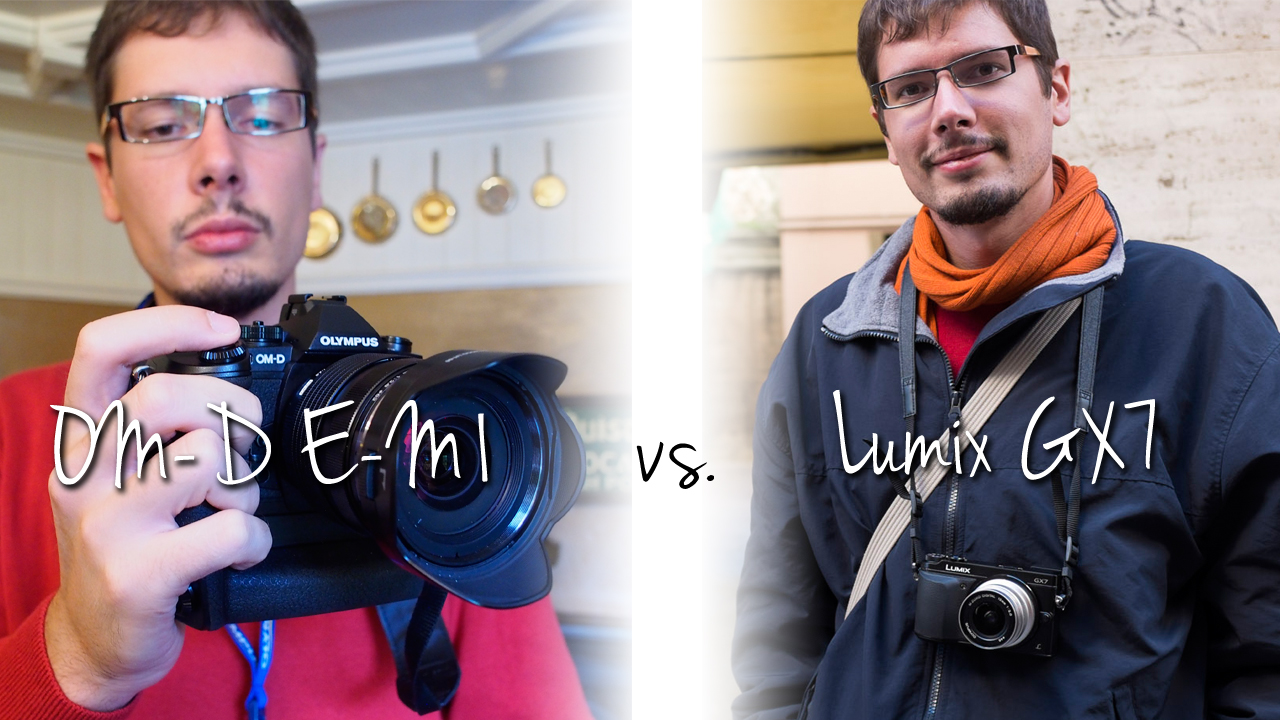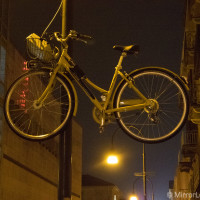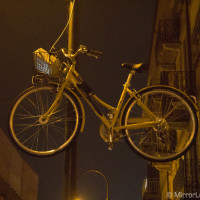At the end of 2013, both Olympus and Panasonic confirmed that they would be cutting back on low-end compact camera production, an inevitable reaction to the dramatic decrease in digital camera sales and the rise of the smartphone as a portable shooting device. As a change in strategy, they will begin investing their money and efforts into mid-to-high end mirrorless Micro Four Thirds models, two of which are the subject of this comparison.
The OM-D E-M1 and Lumix GX7 are representative of Olympus and Panasonic’s change in mindset. Though compact compared to their DSLR counterparts, they aspire to professional heights regarding both image quality and performance.
As always, we aren’t here to say that one model is inherently better than the other. In fact, I’ll say it right up front: both are excellent cameras with very few flaws. Rather, we’d like to help you understand which camera is better suited to you and your photography style. On that note, let’s start comparing!
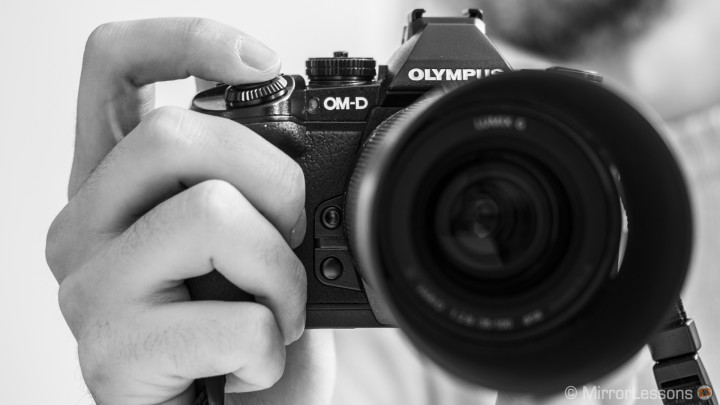
Olympus OM-D E-M1
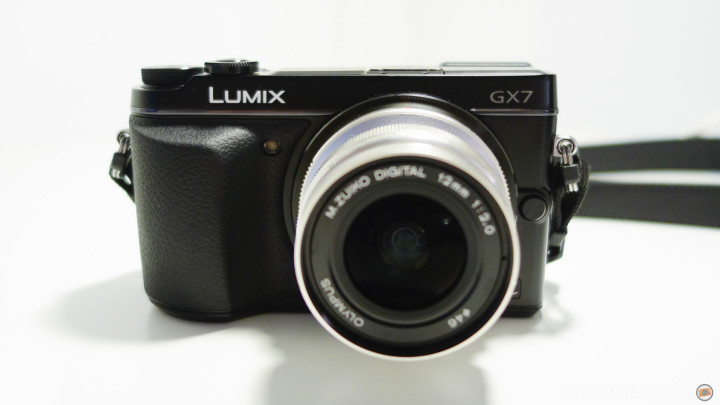
Panasonic DMC-GX7
Main Specs
These two cameras share a similar Micro Four Thirds sensor and the same lens mount, meaning that they produce very similar results for still photography. They also have many technical specs in common. Since both Olympus and Panasonic lenses are fully compatible on both bodies, MFT can be considered the most versatile mirrorless system around.
The OM-D E-M1 is Olympus’ newest flagship, and the first they’ve touted as a Micro Four Thirds camera built for professionals. The most important specs include its marvellous 5-axis stabilisation, hybrid contrast/phase detection AF for improved continuous shooting and tracking, incredible VF-4 EVF with 100% field of view and 1.48x magnification, and its water, dust and freeze proof build.
The GX7 is the first professional Lumix camera built primarily for stills. While its predecessor the GH3 works very well for photography, it is better-known for its video capabilities. Of course, being a Lumix, the GX7 has a professional-grade video codec built into its system. It is also the first Lumix to have built-in stabilisation. Its tilting EVF is both bright and detailed.
OM-D E-M1
- Sensor: 16.3 megapixel 4/3 Live MOS Sensor
- Lens system: Micro Four Thirds interchangeable lens system
- ISO Sensitivity: 200 – 25600 ISO (extended 100)
- Continuous shooting: 10 fps (maximum)
- Autofocus: High‑speed imager AF (Contrast detection / Phase‑difference detection) 81 focusing points
- Internal Stabilisation: Yes (5 axis image stabilisation)
- Viewfinder VF-4 Electronic viewfinder, approx. 2.360K dots and 100% FOV
- LCD Screen: Tiltable 3″ LCD touch monitor
- Movie recording:: Full HD up to 30p
- Weatherproof: Yes
- Dust reduction filter: Yes – Supersonic Wave Filter
- Built-in Flash: No (but an external flash is provided with the camera)
- Extra Features: Built-in WiFi, Art Filters, Panorama Mode (works only with Olympus Viewer 2 software)
- Dimensions: 130.4 x 93.5 x 63.1mm
- Weight: 497g (including battery and memory card)
The DMC GX7
- Sensor: 16.84 megapixel 4/3 Live MOS Sensor
- Lens system: Micro Four Thirds interchangeable lens system
- ISO Sensitivity: 200 – 25600 ISO (extended 125)
- Continuous shooting: 5 fps (maximum)
- Autofocus: Contrast AF system with 23 focusing points
- Internal Stabilization: Yes (Image Sensor Shift Type)
- Viewfinder: LCD tilting Live View Finder (2,764,800 dots equivalent) and 100% FOV
- LCD Screen: 3″ Tilt Static LCD with Touch Monitor
- Movie recording:: Full HD AVCHD up to 60p
- Weatherproof No
- Dust reduction filter: Yes – Supersonic wave filter
- Built-in Flash Yes (TTL Built-in Flash)
- Extra Features: HDR, built-in WI-Fi, silent shutter mode, stop motion animation
- Dimensions: 122.60x 70.7 x 54.6 mm
- Weight Approx. 402g (SD card, Battery, Body)
Ergonomics and Design
The E-M1 and GX7 feature very different yet well-thought-out designs.
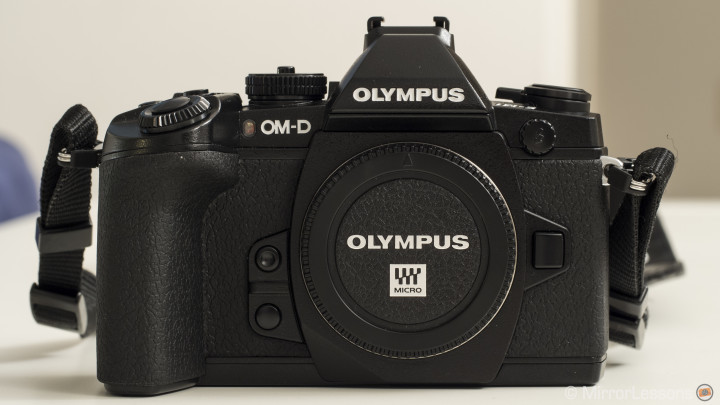
Feelings about the E-M1’s design are mixed. Some, like Kai of DigitalRev, abhor the design, calling it a strange and ugly mix of retro and modernity. Others, like us, consider the design quite attractive, and even more importantly, extremely functional. It basically resembles the E-M5 (which was based on the old Olympus SLR design) with the external HLD-6 battery grip attached.

The GX7, with its rather subdued and discreet appearance, may not be the first camera you’d look at in a store but once you spend some time with it, you’ll find it attractive for its simplicity. Nothing bulges, nothing looks like its been attached at the last minute as a result of carelessness – you can really tell that much thought has gone into keeping its design as minimalistic and as functional as possible.
Being made of magnesium alloy, the build of both cameras is very solid. But there is an important difference regarding their construction…
The OM-D E-M1 is completely dust, water and freeze proof down to -14° C. Pairing it with weather-sealed lenses such as the 12-40mm f/2.8 and other Pro lenses to come, the camera can follow you into the most extreme weather scenarios.
The GX7 doesn’t have a weather-sealed body of any sort. This doesn’t mean it can’t take a few drops of rains along the way but it is certainly more delicate.
And when it comes to ergonomics…
The E-M1 is physically one of the largest mirrorless options out there at the moment, but this is understandable considering the number of features it includes. About the same size as a very small DSLR, it is comfortable to hold and manoeuvre with its protruding grip and well-placed buttons and dials. Its design is aimed at professionals who demand a perfectly ergonomic body to work with, and the E-M1 is exactly that..
The best way to describe the GX7 is that it feels like an extension of your body. Once it is sitting in your hand, you hardly realise its there. In terms of size, it has about the same dimensions as the Fujifilm X-M1, and is quite a bit smaller than the E-M1. Neither the hand grip nor the tilting EVF protrude too much from the body. For photographers who appreciate compactness, the GX7 is by far one of the best mirrorless options out there.
Functionality & Ease-of-use
Both cameras are easy to use but their menu systems are quite different.

The E-M1, as with all Olympus MFT cameras, has a more complex menu system than Lumix cameras. I can guarantee you’ll find certain options placed in sub-menus where they don’t really belong. However, as with anything, it won’t take you long to get used to the layout of the menu.
The main settings of the camera can be accessed from the OK button as well as the dedicated Fn button, the six function buttons, the function lever and the arrow pad. All these options make the E-M1 one of the most customisable cameras I’ve ever used when it comes to button layout. Plus, every function accessed with one of these buttons can be controlled by the two main dials, which are naturally placed where your finger and thumb rest. This makes all the operations very straightforward and quick.

All Lumix cameras have a very straightforward menu both in terms of how the functions are organised and the appearance of the display. Within a matter of minutes, you shouldn’t have any trouble working your way around the various functions of the camera.
The main settings of the camera can be accessed from the Q.Menu which is also the Fn.1 button. It has four function buttons on the body, a customisable arrow pad and five virtual function buttons. The only button that feels misplaced is the LVF/Fn4 which is positioned next to the EVF and is thus harder to reach.
Both cameras feature a high quality tilt and touch screen and electronic viewfinder…
The touch LCD of the E-M1 is about as good as you’re going to get. You can tilt it 80 degrees upward and 50 degrees downward but it doesn’t flip from side to side.
However, the real show-stopper is the built-in EVF with its 100% field of view, 2.36-million dots, and 0.74x magnification. It is by far the best viewfinder we’ve ever used for its detail, brightness, fast refresh rate, colour accuracy, and size.
The touch LCD screen on the GX7 is also very good. It is bright, and you can tilt it up and down but it doesn’t flip from side to side like the LCD on the GH3.
The EVF is very good even though it is smaller than that on the E-M1. Its tilting possibilities make it very useful for some low angle shots or standing in a more comfortable position. I’ve read several reviews which state that it is actually not very useful but I disagree; it can be a great feature if you remember that you have the possibility to use it.
Image Quality
The E-M1 and GX7 have the most recent generation of MFT sensors.
The E-M1 has an updated E-M5 sensor with better high ISO performance from 6400 and up. The lack of the AA filter should also provide sharper results but in our testing we didn’t find any substantial differences in comparison to the E-M5 or the GX7.
The GX7 features a new sensor which has larger photo diodes compared to previous Panasonic MFT sensors and therefore the camera should deliver better image quality in low-light conditions and also have a better dynamic range. While there is a slightl improvement in comparison to the GH3, I didn’t find any substantial difference between it and the E-M1.
If we take a look at some comparison shots between the two cameras at high ISO levels, the difference is hardly noticeable.
The E-M1 has a wonderful colour reproduction, something I already appreciated on the E-M5 and the Pen E-P5. Colours are rich and warm. The JPG engine is also perfect for rendering those colours, and the AutoWB works well.
The GX7 can also render very beautiful colours. In comparison to Olympus cameras, I sometimes find its colours a little bit too cold, especially when using the Auto White Balance and the scenery profile. This is something you can adjust in-camera as the colour profile and Auto WB are customisable.
Below you can see an informal gallery taken with both cameras in various “coloured” conditions:
Concerning dynamic range, both cameras perform in a very similar way. The ORF and RW2 (RAW) files are very versatile but as with any MFT camera, it is important not to blow the highlights too much or you won’t be able to recover much detail.
Several users reported an anomaly concerning the OM-D E-M1 and that would be that the camera produces too much noise for long exposure shots where the NR (or Dark Frame) is disabled. I took a comparison test and it is true that the GX7 has less noise than the E-M1 without the NR activated.
This isn’t a big issue for me as I don’t take lots of long exposure shots and if I need to, I can activate the NR filter without a second thought. But I can understand that for specific astrophotography shots, the superior result of the GX7 is a plus in its favour.
You can also visit these additional E-M1 galleries:
You can also visit these additional GX7 galleries:
Autofocus and Performance
Both cameras are fast but the OM-D E-M1 with its high fps and phase detection AF capabilities is certainly taking all the attention for itself…
The OM-D E-M1 can shoot up to 10fps in AF-S mode. The autofocus is among the quickest I’ve ever used. Its new sensor includes 37 phase detection points that will work in AF-C and tracking mode. The camera is really fast and tracks the subject perfectly. Plus, its phase detection capabilities allow for the use of Four Thirds lenses via an adaptor without losing AF speed.
The GX7 has a continuos shooting of 5fps, so it is a little bit slower than its competitor. Despite having a contrast detection AF system only, the GX7 demonstrated in our tests a very efficient autofocus for both still and moving subjects. While the E-M1 remains the king in this domain, the GX7 follows closely behind, and that’s certainly one of the aspects that impressed us the most.
We used both cameras to shoot a contemporary dance show, which meant shooting fast-moving dancers in a low-light situation. Both cameras did very well with AF and tracking.
The overall performance of the two cameras is very good. But there is a very important difference concerning stabilization.
The E-M1 features the impressive Olympus 5-axis stabilization. It can take shots at shutter speeds as slow as 1 second or even less if you steady your body against a wall or pole. More than once I decided not to use my tripod for night shots as the 5-axis stabilisation allowed me to keep my ISO low and my aperture fairly closed.
The GX7 is the first Lumix body to have internal stabilisation, but it isn’t as effective as the Olympus version. Being an image shift sensor type, it cannot work on many axes like the E-M1. It will work fine for shutter speeds of around 1/50 to 1/20 but slower than that you will start to see the difference between it and the E-M1. Moreover, if you use OIS lenses (stabilised lenses), the built-in IS won’t activate.
Below you can see a comparison conducted with the GX7 and the E-P5, which has the same 5-axis stabilisation as the E-M1.
Video Capabilities
Another important difference between the two cameras can be found in the realm of video.
The E-M1 video mode has been slightly improved from the E-M5 (better bit rate) and allows you to shoot in Full HD with manual control. Its in-body stabilisation works great for hand-held shots. The video codec isn’t the best you can find on a camera at this level: it is excessively compressed. There is no way to completely control the audio manually, and there are only three levels available (low, standard and high). It has a mic input for an external microphone. There is also a time-lapse function that will create a 720p movie.
The GX7 on the other hand has a better video codec like many Lumix cameras and is able to shoot in Full HD up to 60p in AVCHD codec. It doesn’t have the ALL-I codec of the GH3 but AVCHD is fine for most situations. You won’t find a mic input or a mini-jack output socket for your headphones like on the GH3. The camera also features some nice video options such as time-lapse and stop motion animation.
While I wouldn’t consider the E-M1 for professional video shooting, I used the GX7 as a second body along with my GH3 a couple of times. Since the sensors are similar and the GX7 uses the same professional AVCHD codec as the GH3, they can work very well together when you need a small backup body.
Below are two videos shot with the GX7. The first is a short commercial video shot with the GX7 and the GH3. The second is a stop motion animation taken with the GX7 on its own.
Other features
The two cameras distinguish themselves from each other when you look at their extra features.
The E-M1 has a unique feature called Live Bulb (Or Live Time). It allows you to have a preview of a very long exposure on the LCD or EVF. This is a great feature for light painting for example.
It also features the Olympus Art Filters (11 in total) and a new colour creator function that allows you to set the saturation and Hue of your pictures using the two main dials. You can also use the two main dials to change highlights and shadows curves.
The camera also has an HDR function and focus peaking for manual focusing.
The GX7’s most interesting feature is its silent mode. Using the electronic shutter, the GX7 can take a photo in complete silence, and I really mean dead silence. You won’t hear it, it doesn’t make even the slightest noise. Of the several silent modes I’ve tried on various cameras, this is by far the most effective.
The GX7 also features a tone curve adjustment that you can change using the touch screen. You can drag it around any corner of the screen. You will also find focus peaking as well as a a panorama mode.
There are also the Lumix Artistic modes which will render your images in various creative ways.
Note: In September 2014, Olympus released the firmware update version 2.0 for the OM-D E-M1 that adds 8 new features including Live Composite, Keystone Compensation and Tethering.
Both the E-M1 and GX7 include Wi-Fi capabilities.
You can connect the camera wirelessly to a smartphone, tablet, upload your pictures or control the camera remotely. The relative apps on the smart devices allow manual control which is one of the most interesting things. I found the Lumix app more complete with more options to control than the one for the E-M1.
As for the battery life…
The E-M1 has a more than reasonable battery life but if you use it extensively all day, it could run out by the afternoon.
The GX7 has a terrible battery life, almost as bad as Fujifilm batteries. After around 2.5-3 hours of intensive shooting, the battery life bar will show two lines instead of one.
Conclusion
The E-M1 and the GX7 are without a doubt the best MFT cameras to date. They are almost identical when it comes to image quality for stills, so to choose one over the other, you have to look beyond. If I had to summarise the differences in one sentence, I would say that the OM-D E-M1 is aimed more at a professional audience while the GX7 is more for an enthusiast audience.
Choose the EM-1 if:
- Continuous shooting speed is a priority
- You often work in low-light conditions where the 5-axis stabilisation can be of real use
- You are looking for a perfect ergonomics and button layout
- You often work in extreme weather conditions where a weatherproof body is essential
Choose the GX7 if:
- You want better video capabilities
- You desire a compact body
- You want a completely silent operation mode
- You want more video options such as the stop motion animation feature
Reviews
You can also read our full reviews about the two cameras:
